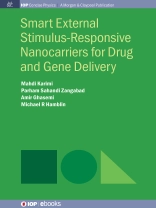The concept of smart drug delivery vehicles involves designing and preparing a nanostructure (or microstructure) that can be loaded with a cargo: this can be a therapeutic drug, a contrast agent for imaging, or a nucleic acid for gene therapy. The nanocarrier serves to protect the cargo from degradation by enzymes in the body, to enhance the solubility of insoluble drugs, to extend the circulation half-life, and to enhance its penetration and accumulation at the target site. Importantly, smart nanocarriers can be designed to be responsive to a specific stimulus, so that the cargo is only released or activated when desired. In this volume we cover smart nanocarriers that respond to externally applied stimuli that usually involve the application of physical energy. This physical energy can be applied from outside the body and can either cause cargo release, or can activate the nanostructure to be cytotoxic, or both. The stimuli covered include light of various wavelengths (ultraviolet, visible or infrared), temperature (increased or decreased), magnetic fields (used to externally manipulate nanostructures and to activate them), ultrasound, and electrical and mechanical forces. Finally, we discuss the issue of nanotoxicology and the future scope of the field.
Inhaltsverzeichnis
Table of Contents: Introduction / Light-sensitive nanocarriers / Temperature-sensitive nanocarriers / Magnetic-responsive nanocarriers / Ultrasound-responsive nanocarriers / Electrical and mechanical-responsive nanocarriers / Nanotoxicology and future scope for smart nanoparticles
Über den Autor
Michael R Hamblin, Ph D, is a principal investigator at the Wellman Center for Photomedicine, Massachusetts General Hospital, an associate professor of dermatology, Harvard Medical School and the affiliated faculty of Harvard–MIT Division of Health Science and Technology. He directs a laboratory of around 12 scientists who work in photodynamic therapy and low-level light therapy. He has published 274 peer-reviewed articles, is associate editor for eight journals and serves on NIH study sections. He has edited ten proceedings volumes, together with four other major textbooks on PDT and photomedicine. In 2011 Dr. Hamblin was honored by election as a Fellow of SPIE.












